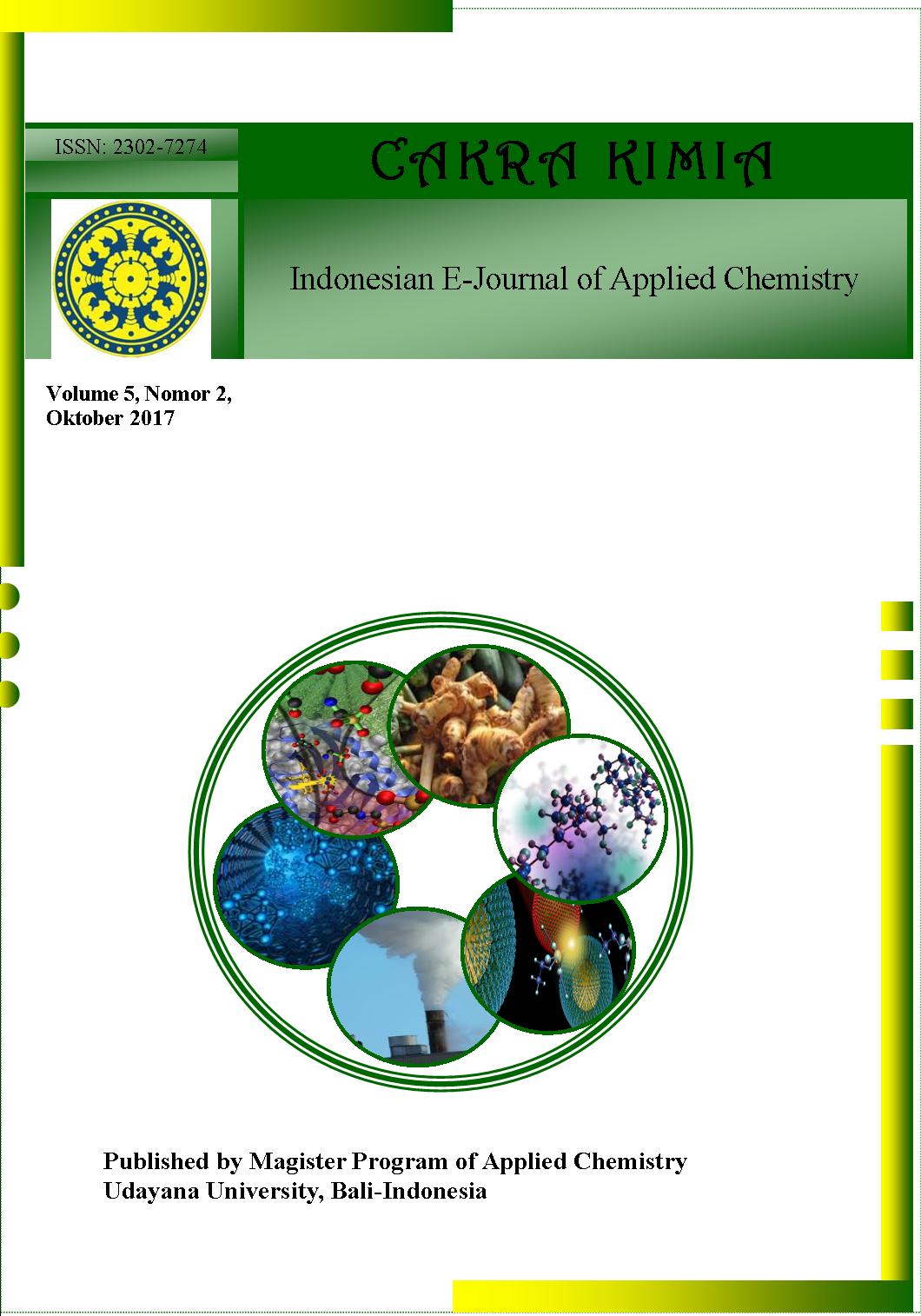PEMANFAATAN ARANG AKTIF DARI LIMBAH TANAMAN GUMITIR (Tagetes erecta) TERAKTIVASI ASAM FOSFAT SEBAGAI ADSORBEN ION Pb2+ DAN Cu2+ DALAM LARUTAN
Abstract
ABSTRAK : Penelitian ini bertujuan untuk mengetahui kapasitas adsorpsi dari arang batang tanaman gumitir (Tagetes erecta) yang diaktivasi asam fosfat (H3PO4) 15% terhadap ion logam Pb2+ dan Cu2+. Arang yang belum dan sudah diaktivasi dikarakterisasi luas permukaan spesifiknya dengan metode adsorpsi terhadap metilen biru dan keasaman permukaannya dengan titrasi asam-basa. Optimasi kondisi penyerapan dilakukan dengan menentukan waktu setimbang, isoterm adsorpsi dan pengaruh pH terhadap kapasitas adsorpsi pada kedua logam. Hasil penelitian menunjukkan bahwa arang teraktivasi memiliki karakteristik yang lebih baik dari pada arang tanpa aktivasi. Arang teraktivasi memiliki luas permukaan dan jumlah situs aktif berturut-turut sebesar 36,4505 m2/g dan 37,1292x1020 molekul/gram sedangkan arang tanpa aktivasi memiliki luas dan jumlah situs aktif berturut-turut sebesar 28,2206 m2/g dan 29,9920x1020 molekul/gram. Waktu kontak terbaik untuk proses adsorpsi Pb2+ dan Cu2+ adalah 60 menit dengan nilai isoterm adsorpsi sebesar 150 mg/L. Kapasitas adsorpsi Pb2+ sebesar 5,0592 mg/g terjadi pada pH 3 sedangkan kapasitas adsorpsi Cu2+ sebesar 5,7867 mg/g terjadi pada pH 4. Proses adsorpsi arang batang gumitir teraktivasi H3PO4 dalam penelitian ini tergolong kemisorpsi dengan pola isoterm adsorpsi tipe Langmuir dengan nilai koefisien determinasi Pb2+ sebesar 0,9935 dan Cu2+ sebesar 0,9944.
ABSTRACT : The aim of this study is to find out the adsorption capacity of the phosphoric acid (H3PO4)-activated marigold (Tagetes erecta) stem carbon in reducing Pb2+ and Cu2+ from their solutions. The activated carbon was characterized by determining its specific surface area using methylene blue adsorption method and the surface acidity by acid-base titration technique. Optimization of the absorption conditions was carried out by determining the equilibrium time, isotherm adsorption and the effect of pH on adsorption capacity on both metal ions. The results showed that activated carbon has better characteristics than carbon without activation. The activated carbon have a surface area and active sites of 36,4505 m2/g and 37,1292x1020 molecules/gram, respectively, while for carbon without activation of 28,2206 m2/g and 29,9920x1020 molecules/gram, respectively. The equilibrium time adsorption of Pb2+ and Cu2+ was 60 min and the adsorption isotherm value was of 150 mg/L. The adsorption capacity of Pb2+ at pH 3 was 5.0592 mg/g while the adsorption capacity of Cu2+ was 5.7867 mg/g at pH 4. The adsorption process of the H3PO4-activated carbon in this study was classified as chemisorption with adsorption pattern of Langmuir with determination coefficient for Pb2+ and Cu2+ are of 0.9935 and 0.9944, respectively.
Downloads
References
[2] Pino, G. H., Mesquita, L. M. S., Torem, M. L., and Pinto, G. A. S., 2005, Biosorption of Cadmium by Green Coconut Shell Powder. Metallurgy and Material, Rio de Janeiro-RJ, Brazil
[3] Sudarmaji, Mukono, J., Corie, I.P., 2006. Toksikologi Logam Berat B3 dan Dampaknya Terhadap Kesehatan, Journal Kesehatan Lingkungan, 2 (2): 129 – 142
[4] Hubeey, J. E., Keiter, E. A., and Keiter, R. L., 1993, Inorganic Chemistry: Orinciple of Structure and Reaktivity (4th ed), Harper Collins College, New York
[5] Mars, H., dan Reinoso, F. R., 2006, Activated Carbon, University of Alicante, Elsevier Science and Technology Books
[6] Cooney, D. O., 1980, Activated Charcoal,Antidotal, and Other Medical Uses, Marcel Dekker, New York
[7] Qin C., Yao C., and Jian M.G., 2004, Manufacture and Characterization of Activated Carbon From Marigold Straw (Tagetes erecta L) by H3PO4 Chemical Reaction, Materials Letters, 135: 123-126
[8] Siaka, I.M., 2016, Pembuatan Dan Karakterisasi Arang Aktif Batang Tanaman Gumitir (Tagetes erecta) Pada Berbagai Suhu Dan Waktu Pirolisis, Cakra Kimia (Indonesian E-Journal of Applied Chemistry), 4 (2) : 168-177
[9] Sahara, E., 2016, Pembuatan Dan Karakterisasi Arang Aktif Batang Tanaman Gumitir (Tagetes erecta) Yang Diaktivasi Dengan H3PO4, Jurnal Kimia, 11 (1) : 1-9
[10] Castellan, G. W., 1982, Physical Chemistry, Third Edition, General Graphic Servies, New York
[11] Gultom., E, M. dan Lubis, M. T., 2014. Aplikasi Karbon Aktif Dari Cangkang Kelapa Sawit Dengan Aktivator H3PO4 Untuk Penyerapan Logam Cd dan Pb, Jurnal Teknik Kimia USU, 3 (1): 5 – 10
[12] Cool, P., and Vansant, E. F., Pillared Clays: Preparation, Characterization and Applications, Laboratory of Inorganic Chemistry, University of Antwerp, USA
[13] Bhattcharyya, KG and Gupta, S.S., 2007, Adsorptive Accumulation of Cd(II), Cu(II), Pb(II) and Ni(II) from Water On Montmorillonite, Influence of Acid Activation. Journal Of Colloidand Interface Science, 310: 411-424
[14] Atmoko, R.D., 2012. Pemanfaatan Karbon Aktif Batubara Termodifikasi TiO2 pada Proses Reduksi Gass Karbon Monoksida (CO) dan Penjernihan Asap Kebakaran, (Skripsi) Fakultas Teknik, Universitas Indonesia
[15] Sukardjo., 1990, Kimia Anorganik, Rineka Cipta, Jakarta
[16] Tumin, N. D., Chuah, A, L., Zawani, Z., dan Rasid, S. A., 2008. Adsorption of Copper from Aqueous Solution by Elais Guineenis Kernel Activated Carbon. Journal of Engineering, Science and Technology, 3 (2): 180 – 189



 Petunjuk Penulisan
Petunjuk Penulisan
